The Samsung Galaxy Note7 (S820) Review
by Joshua Ho on August 16, 2016 9:00 AM ESTSystem Performance Cont'd
Now that we've covered more general purpose benchmarks that tend to emphasize CPU performance and GPU compute performance, we can look at benchmarks that tend to more strongly emphasize things that games will see benefits from such as improved GPU graphics performance and improved CPU physics processing performance.
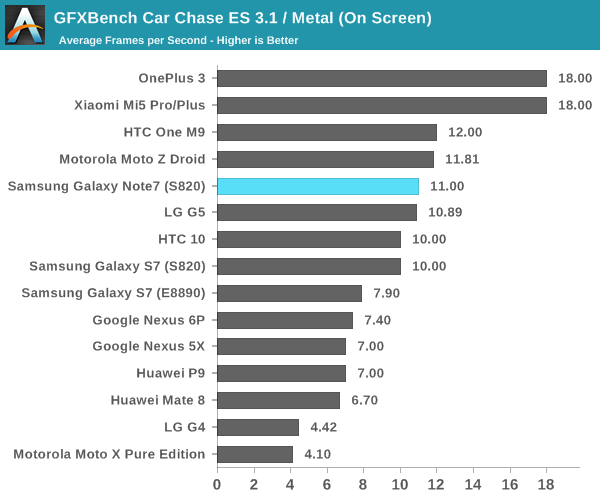
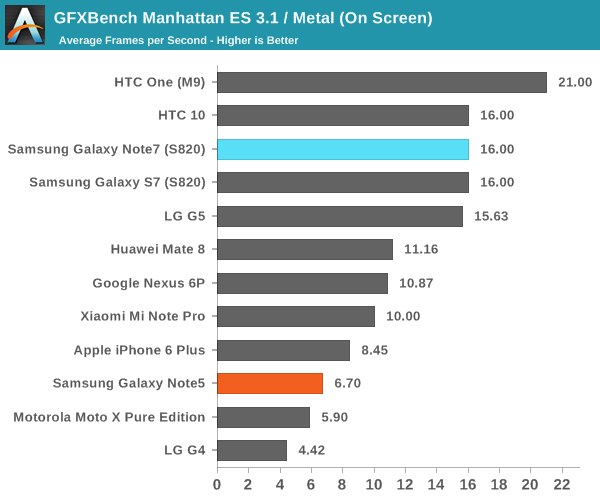
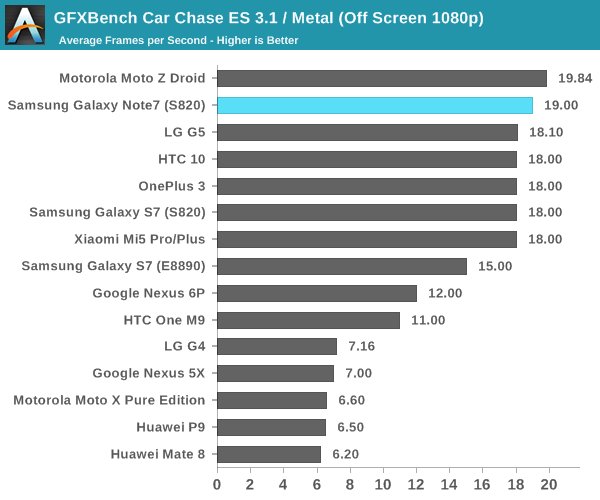
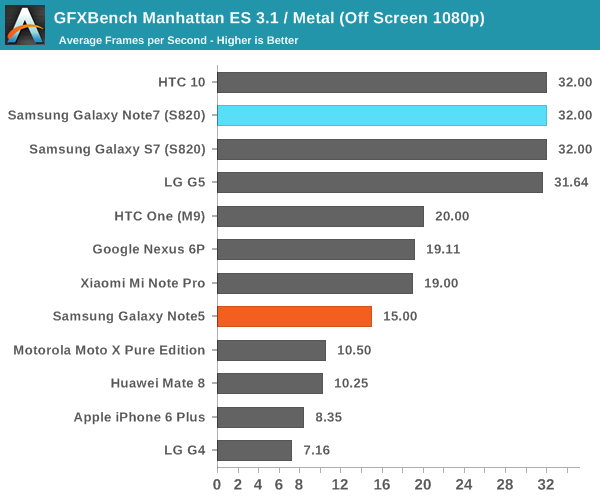

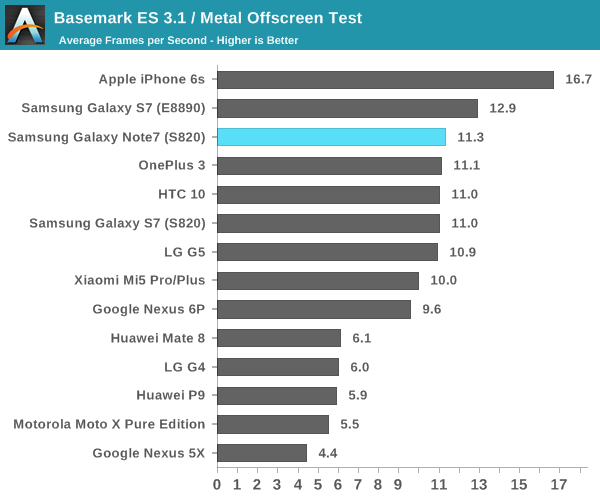
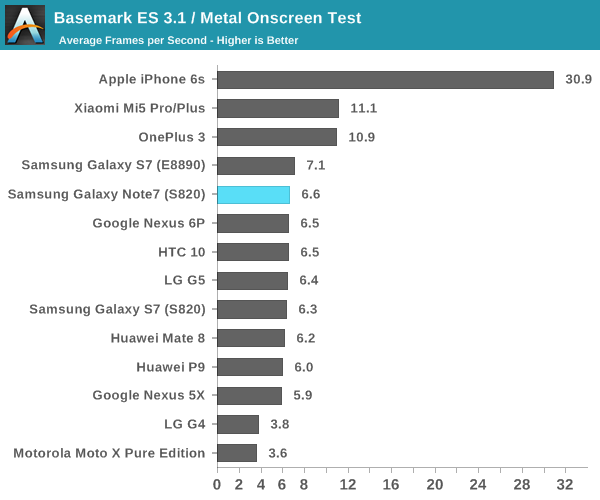
It's probably no surprise, but the Galaxy Note7 performs as expected with the latest drivers and in ideal thermal conditions. The Adreno 530 should be more than sufficient for the forseeable future but for maximum performance it's best to enable 1080p rendering or lower to maximize frame rates in games like Real Racing 3 that tend to really use the GPU to its fullest extent.
NAND Performance
Of course, while Discomark provides a sort of holistic view of performance for a specific task, it’s also important to at least try and break down the various aspects that impact system performance so rather than simple black box testing we can further understand what factors influence performance and therefore provide additional information to make better buying decisions. One of the major contributors to general purpose performance is going to be storage performance, which is often something often ignored by marketing as the nitty gritty details of NAND storage realistically require some background in solid state physics and devices to understand, as well as some understanding of computer science and engineering.
While I’m not really happy with the state of our mobile storage benchmarks, for now I don’t really see another option here as the publicly available storage benchmarks for Android and iOS are fairly basic. Putting aside the state of the benchmarking industry, our current benchmark remains AndroBench 4 which provides at least some basic storage benchmarking capabilities. We use custom settings with this benchmark which attempts to make the test more realistic as the default settings are just wildly unrealistic. This includes adjusting the buffer size, increasing the file size to 100 MB, and only using one thread instead of 8. 256KB file size is targeted as this is the most common block size if you profile this kind of thing for sequential writes and reads, while 4KB block sizes are the most common for other tasks as the vast majority of computer architectures use 4KB pages for virtual memory. Single-threaded I/O is common in most cases because multi-threaded programming is still difficult for most people to reason about in an effective manner because conscious thought is inherently serial in nature with some multiplexing. In addition to this, many eMMC solutions on the market don’t really perform well with multiple threads simultaneously as the controller can’t do anything with extra requests other than reply with a busy signal which already happens with a single thread.
Putting aside discussions of testing we can take a look at the storage solution used in the Galaxy Note7 before getting into the actual results. The Note7 continues to use basically the same storage solution as the Galaxy S7 and S6, which is to say an MLC-based solution that has a UFS Gear 3 single lane interface for bandwidth up to 600 MB/s and basically has the exact same model number if you check the SCSI devices attached to the system save for some changes that indicate the higher 64GB storage relative to the 32GB chips that are most common in the Galaxy S7.
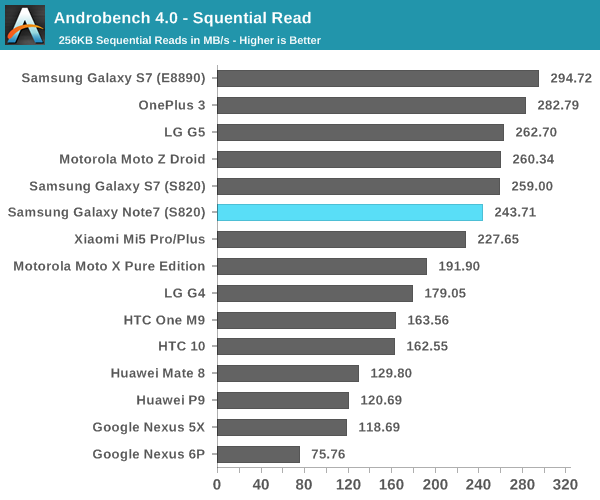

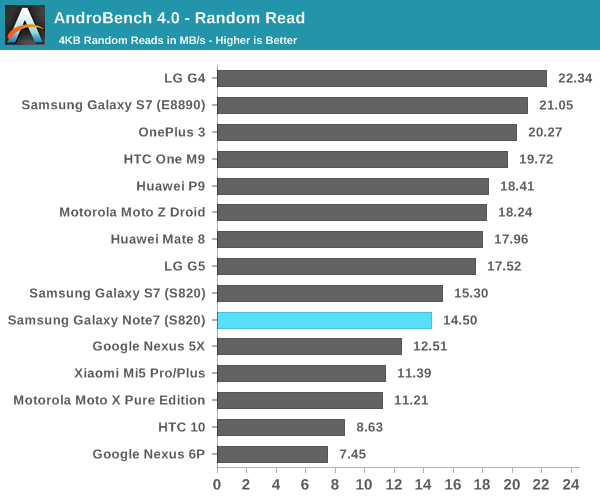
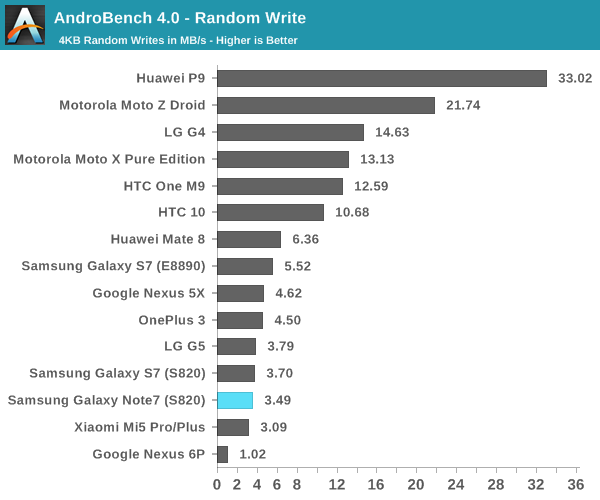
Looking at the test results it performs exactly as quickly as you’d expect from this MLC solution as we’ve tested it in the Galaxy S6, S6 edge, S6 edge+, Note5, S7, S7 edge, and now the Note7 as well as the LG G5. The performance here is acceptable but obviously if you look at burst performance the iPhone 6s has a faster solution due to the hybrid SLC/TLC storage solution. The main benefit of pure MLC NAND is that performance is more consistent as there’s no precipitous drop when the SLC buffer fills. There’s always room to improve but I don’t really see how it’s going to happen unless Samsung moves to V-NAND for the next generation.










202 Comments
View All Comments
lilmoe - Tuesday, August 16, 2016 - link
SD820 has the power more fluidly? Yes. Better than Exynos? Ummm... No.If you want smoother UI and better touch response, root and change the governor to Performance, or Ondemand.
lilmoe - Tuesday, August 16, 2016 - link
I've dug a little deeper into this after I bought my GS7e (Exynos). Looks like Exynos (and it's higher count of cores) plays better than the Snapdragon with the Conservative Governor that Samsung employs to save battery life. You can manually switch it to Ondemand, Interactive, or even better, Performance (eliminating most of the UI performance differences, and increase the responsiveness of the device drastically). But battery life would take a major hit, just like every other Android device with a 1440p screen.What needs to fixed and optimized is ANDROID. Google still insists on doing a crappy job with their OS, just like with their browser.
lilmoe - Tuesday, August 16, 2016 - link
"What needs to fixed and optimized is ANDROID. Google still insists on doing a crappy job with their OS, just like with their browser."What also needs to be fixed is the "higher resolutions screen is better" mentality. No smartphone should have more than a 1080p panel for optimal performance and efficiency.
There's absolutely no mention of the new power saving features that the new version of TouchWiz employs; like scaling down the resolution and how much more battery life you get out of that. Guess I'll have to test it myself when my GS7 gets the update. I'm soooooooooooooooooooooo scaling back the resolution to 1080p while leaving processing power intact.
InspectHerGadget - Wednesday, August 17, 2016 - link
Yes. The extra screen resolution is not worth the hit on battery life. Android and Samsung are also both to blame for poor optimisations. I had the Nokia 1520 which had great battery life, then the Note 5 which had only so so battery life, now the iPhone 6S Plus which has great battery life. On the Note 5 if I left the hotspot on it would get hot and drain the battery even when my Microsoft Pro 4 was in its case. I just felt too many rough edges on Samsung phones I had.jospoortvliet - Thursday, August 18, 2016 - link
Remember, guys, amoled isn't hit by lower efficiency on higher resolution, that is only an LCD problem. Now granted the gpu and cpu have to work a little harder but 1080P wouldn't look nice with pentile and Samsung does pentile to get a better endurance/longevity and brightness out of AMOLED. I don't think they made the wrong choice here. And yes, 1440P on an LCD is stupid.lilmoe - Tuesday, August 16, 2016 - link
Sorry, the governor they use is Interactive, not conservative...jospoortvliet - Thursday, August 18, 2016 - link
Then it shouldn't be an issue and if it is - they shold fix the governor not switch to performance. The performance governor is barely faster at big costs.lilmoe - Thursday, August 18, 2016 - link
It doesn't act like an Interactive governor would act at all, it's very slow to ramp up clock speed, and most ramps up the little cores. It's a good thing for battery life, but not as good for fluidity.jospoortvliet - Thursday, August 18, 2016 - link
IMHO the on demand governor should really not be costing battery life. It was designed to be a good balance and it generally is, at least on desktop.Then again with such an outdated kernel with patches who knows what is in there... wish the android vendors would get their stuff up streamed more timely...
grayson_carr - Tuesday, August 16, 2016 - link
It's a conscious decision happening at Samsung. They could tweak the kernel / governor configuration so that there are almost no frame drops and slowdowns, but it would come at the cost of battery life. Samsung is aiming for the minimum performance they think their users won't be annoyed with in order to maximize battery life, which Samsung assumes is more important to the average user. Google on the other hand configures their devices so that they maintain 60 fps in most scenarios, and their battery life suffers for it. I personally prefer Google's approach because I value a smoother and stutter free UI more than a little extra battery life, but I think a lot of people who buy Nexus devices are baffled as to why the battery life isn't as good as their Samsung phone even though the battery is just as large. Those people may prefer battery life over the smoothest UI possible.